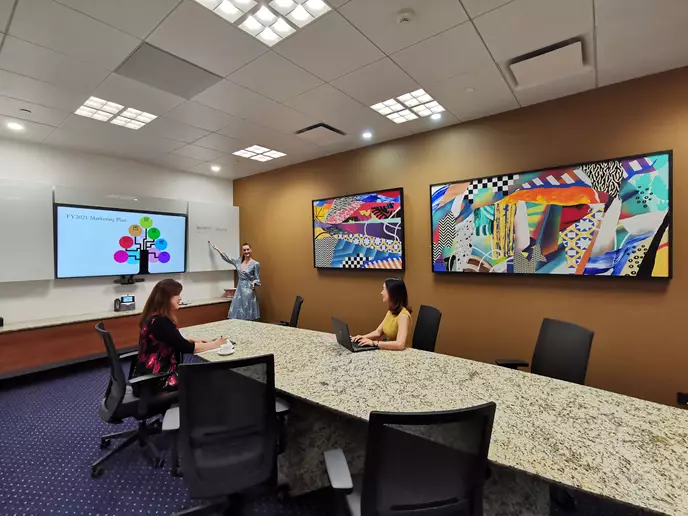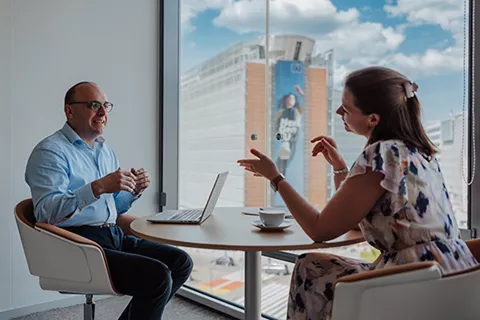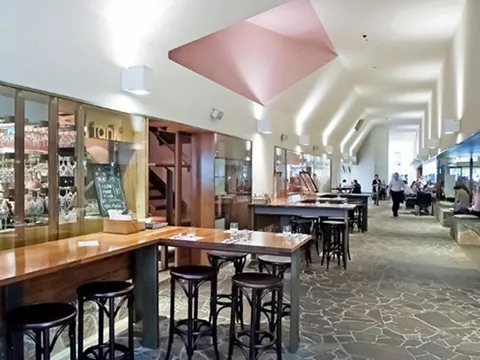
Choosing the right space can make a significant difference in the success of a meeting or event in the world of business and professional interactions. Are you planning to host a meeting with important clientele?
If so, you’ve likely encountered the terms “conference room” and “meeting room”. These spaces are essential for brainstorming sessions, presentations, negotiations, and decision-making in the corporate landscape.
Understanding the distinctions between these spaces is paramount regardless of whether you are a seasoned professional or a budding entrepreneur. This article will explore the nuances of conference rooms and meeting rooms while highlighting the definitions, purposes, and key differences.
Let's dive in to uncover the essentials of conference and meeting rooms and help you choose the right setting for your next important gathering.
Key Points:
- Understanding the definitions and purposes of conference rooms and meeting rooms.
- Exploring the key differences that set these spaces apart.
- Help you choose a suitable space for your specific needs.
Considering a redesign of your office? Find out the best office design ideas for small business.
What is a conference room?
A conference room, often referred to as a conference venue or meeting space, is a designated area within an office or a separate facility explicitly designed to host formal meetings, presentations, and discussions.
![A team of corporate workers using a conference room]()
These spaces represent the quintessential conference room style. They exude professionalism and are ideally suited for executive meetings and high-stakes decision-making.
Typically furnished with an elongated conference table and executive chairs, conference rooms often feature advanced audio-visual equipment to facilitate presentations and discussions.
What does a conference room have?
Not all conference rooms have the same features and utilities, but some general characteristics define one.
- Size and capacity: A conference room varies in size and can accommodate many attendees. The capacity is dependent on the layout and this often plays into the cost of building or renting one.
- Technology: A hallmark of the traditional conference room is its range of advanced technology that makes work productive. Audio-visual equipment, projectors, screens, video conferencing systems, sound systems and technology that enables seamless communication are typical in these spaces.
- Privacy and acoustics: Confidential discussions or private meetings are often held in these spaces, so acoustics are carefully considered to minimize noise interference from external sources,
- Furniture: Comfortable chairs and tables come with every conference room. But additional furnishing can customized based on the meeting’s purpose.
- Lighting: Most conference rooms will have adjustable lighting options to cater to different meeting requirements.
Examples of how a conference room can be used
To illustrate the diverse range and versatility of conference rooms, let’s delve into some common examples of how they are used.
Training room
Conference rooms can be an excellent venue for hosting staff training sessions. They are specifically outfitted with the tools and technology for employee development. The large screens typical of these spaces are suitable for presenting and teaching a large group without difficulties.
Video conferencing room
If you’re hosting virtual meetings with important clients or connecting with remote colleagues from across the globe, then a conference room is ideal. The high-quality video and audio equipment ensure effective communication, while the room's design creates a professional environment.
Large auditorium
These are designed to host conferences, seminars, and events with many audiences. Generally, they are equipped with the best seats, quality acoustics, and advanced audio-visual systems to ensure clear and engaging presentations.
What is a meeting room?
A meeting room, often referred to as a dedicated meeting room or company meeting room, is a designated space within an office or workplace set aside for the primary purpose of conducting meetings, discussions, and collaborative sessions.
![A team of professionals using a meeting room for collaboration.]()
![A team of professionals using a meeting room for collaboration.]()
These rooms are integral to fostering effective communication and decision-making within an organization. All office spaces should have company meeting rooms or they should consider renting one on a pay-per-usage basis.
Key Tip: Don’t have access to a conference room or boardroom? Explore workspace solution providers such as Servcorp, that offer flexible meeting rooms for all business needs.
What does a meeting room have?
Meeting rooms cater to various collaborative needs and provide the amenities needed to make this happen. Although modern office space might replace meeting rooms with breakout areas, most organizations still stick by the benefits of it.
- Informal setting: Some meeting rooms have comfortable seating and a more informal atmosphere. These are better suited for casual discussions and team brainstorming sessions.
- Technology integration: Meeting rooms generally have essentials such as projectors, screens, and audio systems but are less technologically advanced than conference rooms.
- Size: Just like any room in an office space, the size of a meeting room can vary. They can be in larger rooms for presentations or cozy smaller spaces for team discussions.
- Design: A new office space might have a meeting room that’s more of a collaborative station, while old school offices may still adhere to the traditional layout.
- Privacy: Meeting rooms are no less private than conference rooms and are built to foster concentration while situating the occupants away from the distractions of an open office environment.
Examples of how a meeting room can be used
This can be straightforward, but you may notice the difference between a conference room vs meeting room as we list how a meeting room can be used.
Team meetings
Obviously, meeting rooms can be used for regular updates, strategy discussions, and project reviews with your team. Think of it as a space where you can gather an entire team and everyone provides their input on overarching team goals.
Interviews
This is a perfect environment for interviewing potential employees because they are small enough to be personable but formal enough to hold such a meeting. Hosting an interview in executive offices is another great alternative, but using a meeting space is just as common.
Collaborative work
Meeting rooms on the smaller side are perfect for collaborative work that requires constant hands-on effort.
You might be a marketing team tasked to brainstorm ideas for an upcoming advertising campaign. Team members can utilise the dedicated space for sharing concepts, sketching visuals, and refining their strategy without distractions.
The atmosphere is conducive to creativity to ensure the project progresses smoothly.
The key differences between a conference and a meeting room
Understanding the distinctions between these two essential spaces is important. While they are similar in function, the unique advantages determine the nature of your gathering.
Let’s delve into the key difference between the two.
Purpose and formality
- Conference room:
- Typically used for formal and high-stakes meetings.
- It is commonly used during executive-level discussions, board meetings, and important client presentations.
- Emphasises the seriousness and professionalism of the discussions at hand.
- Meeting room:
- A flexible option for various types of gatherings.
- Suitable for formal and informal meetings.
- Used more for smaller scale tasks such as brainstorming or collaborative work.
Size and capacity
- Conference room:
- Mostly larger and suitable for medium to larger groups.
- The capacity can range from 10 to 50 ore more people.
- Meeting room:
- The better option for accommodating small to medium-sized groups, usually up to 15 people.
- It comes in a variety of sizes but still smaller than conference rooms.
Technology and equipment
- Conference room:
- Features advanced technology with the best audio-visual systems.
- Equipped to host large-scale video presentations seamlessly.
- Designed to impress your clients and engage with multimedia functions.
- Meeting room:
- Technology offerings are basic, such as projectors and screens.
- Functionality is the primary focus as opposed to high-tech sophistication.
- Best used for presentations on a smaller scale.
Formality of furniture and layout
- Conference room
- On the more glamorous side with executive-style tables and chairs.
- Shows a clear emphasis on hierarchy and formality in the layout.
- It may be a more rigid arrangement.
a
- Meeting room:
- Flexible furniture and layout options to suit the nature of your meeting.
- Encourages dynamic and interactive discussions.
- It doesn’t create an imposing sense of hierarchy where not everyone can speak.
When to Choose a Conference Room vs Meeting Room?
Choosing between a conference room and a meeting room doesn’t have to be complicated. Think about why you're meeting, how many people are coming, and how formal things need to be. Here’s a quick guide to help you figure out what suits your situation best:
Go with a Conference Room If:
-
You're meeting with important clients or investors and want to leave a strong impression.
-
Privacy and a polished, professional setting are a must.
-
You need high-end tech for a big presentation or virtual meeting.
-
You’re planning a larger session, like training or a seminar.
-
The meeting involves serious topics, strategy, or decision-making at a high level.
Opt for a Meeting Room If:
-
It’s an internal catch-up, project update, or team sync.
-
You’re after something more affordable and flexible.
-
The goal is collaboration and idea-sharing (think: brainstorming).
-
You’re interviewing someone or having a one-on-one chat.
-
The meeting is short, laid-back, and doesn’t need fancy equipment.
At the end of the day, it’s all about what your meeting needs. Pick the space that matches the tone and helps everyone stay focused and comfortable.
Rent your conference or meeting room
Now that you know the key differences between these two essential meeting spaces, your business will be better equipped to select an appropriate workspace for any occasion.
The beauty of the corporate landscape lies in its diversity. Whether you're orchestrating a boardroom meeting that could change your company's future or gathering your team for a pivotal brainstorming session, these spaces are your tools. Design also plays an important role, for example a U-shaped boardroom layout may be more suitable based on your event - it's the little details that add up.
Depending on the occasion, businesses can rent a meeting room for a day or impressive boardrooms near you. The next time you find yourself at the crossroads of a meeting, consider the role the room itself can play in your success.
Frequently Asked Questions









